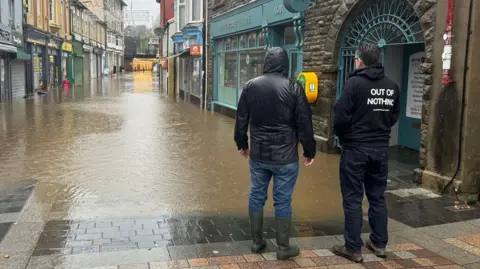How are flood alerts and weather warnings set?
 BBC
BBCFlooding across south Wales has left residents angry at what they say was a lack of preparation and insufficient warning.
Andrew Morgan, leader of Rhondda Cynon Taf (RCT) council, said he was "amazed" that only a yellow weather warning was put in place, saying an amber warning was expected.
Meanwhile, Pontypridd resident John Pockett said: “The one thing I think is appalling in this is: where was the warning? Nobody had heard anything at all.”
But how are flood alerts and weather warnings set?
The Met Office has stated that Storm Bert was “well forecast” in advance “with a number of warnings in place”.
“As always with a named storm, a full assessment of the forecast and warning strategy will take place with our partners,” said Met Office services director, Simon Brown.
“I would expect this to take place over the coming days.
“The warnings covering Wales highlighted the potential for homes and businesses to flood with fast flowing or deep floodwater was possible, causing a danger to life.”
How are these weather warnings issued, and what happens when they are?
How are weather warnings set?
The Met Office issues weather warnings via its National Severe Weather Warning Service.
The warnings themselves come in three different levels – yellow, amber, and red – which are used to alert the public to the seriousness of the weather situation.
They’re based on the impact level as well as likelihood of it happening, but this means they can have quite broad meanings.
For example – a weather situation with high impact, that’s unlikely to happen would be given a yellow weather warning, the same as a situation with low impact, that’s highly likely to happen.
For this reason, it’s important to check what the weather warning actually means when a yellow or amber warning is issued.
What does each category mean?
There’s no single meaning for each category of weather warning, so it’s important to check the individual warnings in your area for context.
Yellow warnings, such as the one issued across south Wales in advance of Storm Bert, can represent a wide variety of weather situations.
They’re often issued when it’s likely that the weather will cause low impact, which includes some disruption to traffic and travel.
However, they can also be issued when a situation may have a high impact, but the likelihood of that happening is much lower.
Amber warnings usually mean that there’s an increased likelihood of a weather situation occurring, with the possibility of travel delays, road closures, power cuts, and potential risk to life and property.
Consider changing travel plans if an amber warning is in place, and consider whether there’s anything you can do to minimise the impact on your family and property.
Red warnings mean that dangerous weather is expected. You should prioritise keeping yourself and other safe.
Risk to life is high in these situations, with substantial disruptions to roads, travel, power, and a possibility of widespread property damage.
Avoid travel where possible, and take advice from emergency services.
Up-to-date weather warnings for across the UK can be found on the BBC Weather website.
You can see also see if warnings have been issued for your area on the BBC Weather app.
How are flood alerts issued in Wales?
Natural Resources Wales issues flood alerts across Wales, based on river levels across the country.
River levels are recorded at 350 different river level and flow monitoring stations across Wales, with the readings sent to its head office in Cardiff for analysis.
“When it starts raining, we take forecast rainfall data from the Met Office and we also take observed river levels,” said Natural Resources Wales flood forecasting specialist advisor, Samantha Mitchell.
“They go into our models and the models work out what might be happening… and whether that might be passing any flooding thresholds. We pass that information on to the flood warning duty officers and they will decide whether to issue any flood warnings to the public.”

Flood predictions are then made, and alerts are issued if needed – these can be found on the Natural Resource Wales website.
How much notice will you get with flood alerts?
The amount of notice you’ll get with a flood warning will depend on where you live.
Basically, some rivers flow faster than others – some of Wales’ fastest flowing rivers are in south Wales, where they drain off the old coalfields, or Bannua Brycheiniog (the Brecon Beacons), such as in Neath Port Talbot or Rhondda Cynon Taf.
Larger rivers such as the Severn, Towy, and Wye respond more slowly to rainfall, so those living nearby can expect more warning when it comes to flooding.
You can sign up for flood warnings at the Natural Resources Wales website.
